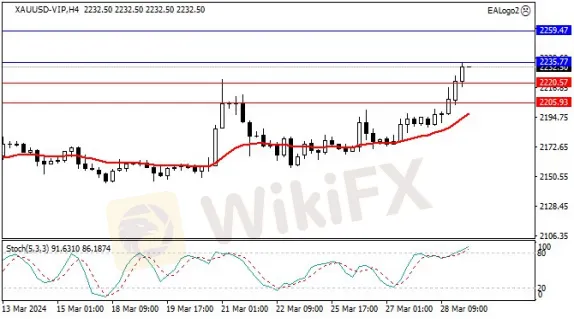简体中文
繁體中文
English
Pусский
日本語
ภาษาไทย
Tiếng Việt
Bahasa Indonesia
Español
हिन्दी
Filippiiniläinen
Français
Deutsch
Português
Türkçe
한국어
العربية
MHMarkets:2024.03.29 MHM European Time Analysis
Abstract:Fed Governor Christopher Waller's recent comments have highlighted a cautious stance towards adjusting interest rates, marking a significant moment for the financial markets.
Date: 2024.03.29 MHM European Time Analysis
Fed Governor Christopher Waller's recent comments have highlighted a cautious stance towards adjusting interest rates, marking a significant moment for the financial markets. Waller's perspective, emphasizing the need to wait before considering rate cuts due to disappointing inflation numbers, diverges from Fed Chair Powell's more optimistic view on easing price pressures. This divergence has led to a recalibration of investor expectations, evident in the diminished likelihood of a June rate cut and adjustments to the anticipated rate reductions by year-end. The upcoming core PCE index report, a key inflation measure favored by the Fed, now holds increased significance, potentially influencing the dollar's trajectory and future rate decisions.
The Japanese yen experienced a notable recovery against the dollar, buoyed by stronger intervention warnings from Japan's monetary authorities. This response came after a meeting among Japan's central monetary bodies to address the yen's depreciation, indicating readiness to counter speculative market moves. While the yen's gain stood out amidst the dollar's general uptrend, future dynamics could shift, especially if the forthcoming PCE data further bolsters the dollar. Such developments could prompt intervention if the yen's depreciation accelerates, underscoring the delicate balance authorities seek to maintain in currency markets.
Wall Street witnessed a positive session, with major indices closing higher, buoyed by optimistic sentiments and the potential for future rate cuts to bolster market valuations. Similarly, gold's resilience in the face of a strengthening dollar reflects a broader strategic move by central banks to diversify reserves, hinting at sustained support for the precious metal. The financial landscape is thus poised at a critical juncture, with upcoming inflation data set to influence not only the Federal Reserve's policy path but also investor strategies across various asset classes, from currencies to commodities and equities.
| Gold (XAUUSD) Technical Analysis | |
| Resistance levels: | 2235.77; 2259.47 |
| Support levels: | 2220.57; 2205.93 |
 | |
| Crude Oil (USOUSD) Technical Analysis: | |
| Resistance levels: | 84.17; 85.88 |
| Support levels: | 82.76; 80.85 |
 | |
| EUR/USD Technical Analysis: | |
| Resistance levels: | 1.0808; 1.0842 |
| Support levels: | 1.0769; 1.0737 |
 | |
| GBP/USD Technical Analysis: | |
| Resistance levels: | 1.2655; 1.2703 |
| Support levels: | 1.2581; 1.2541 |
 | |
Disclaimer:
The views in this article only represent the author's personal views, and do not constitute investment advice on this platform. This platform does not guarantee the accuracy, completeness and timeliness of the information in the article, and will not be liable for any loss caused by the use of or reliance on the information in the article.
Read more

MHMarkets:2024.03.28 MHM European Time Analysis
In the forex market, stability was the theme for the U.S. dollar index, holding firm at 104.30. Minor fluctuations were observed across major currency pairs: the Euro slightly weakened against the dollar, closing at 1.0827

MHMarkets:2024.03.27 MHM European Time Analysis
In the latest market wrap focusing on the foreign exchange sector, the U.S. dollar index showed minimal movement, holding at 104.31.

MHMarkets:March 27, 2024 Economic Highlights
On Tuesday, due to February's US durable goods orders growth exceeding expectations and an optimistic economic growth outlook for the first quarter in the US, the US dollar index initially fell but then rose, briefly touching below the 104 mark before recovering during the US trading session, closing up 0.07% at 104.29.

MHMarkets:2024.03.26 MHM European Time Analysis
In the foreign exchange market, the U.S. dollar showed a decline against a basket of major currencies, with the dollar index dipping to 104.22.
WikiFX Broker
Latest News
Why Are Financial Firms Adopting Stablecoins to Enhance Services and Stability?
Experienced Forex Traders Usually Do This Before Making a Lot of Money
Octa vs XM:Face-Off: A Detailed Comparison
When High Returns Go Wrong: How a Finance Manager Lost RM364,000
Bridging Trust, Exploring Best—WikiEXPO Hong Kong 2025 Wraps Up Spectacularly
Interactive Brokers Expands Crypto Trading with Solana, XRP, Cardano, and Dogecoin
Fidelity Investments Explores Stablecoin Innovation in Digital Assets Sector
Why More People Are Trading Online Today?
SEC Ends Crypto.com Probe, No Action Taken by Regulator
Broker Comparison: FXTM vs XM
Currency Calculator







